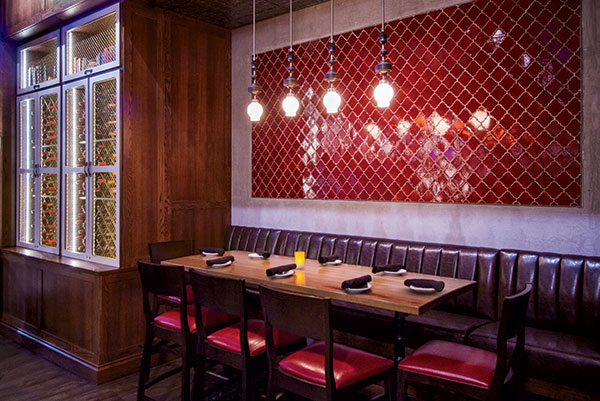During the pandemic, the importance of air circulation and open spaces suddenly became critical.
Fast forward three-plus years, and more foodservice operators are expanding spaces and increasing dining area functionality by incorporating retractable roofs and doors.
Retractable roofs and doors are suitable for virtually any type of dining space where outdoor seating can be expanded. They offer high flexibility during inclement weather. Doors that fully open a space don’t have many limitations in terms of location and installation. The main requirement for a roof that retracts is that the restaurant must be a single story, otherwise the dining space that will be uncovered needs to be on the top floor.
Operators can generally see a quick return on investment, as little as six months, according to manufacturers, as outdoor spaces can be used year-round with retractable roofs.
Why Add Retractables?
Retractable roofs and doors can increase the dining square footage while also adding fresh air and natural light into the space. These can be incorporated into any type of concept, whether formal or casual, and can even be a part of a restaurant’s brand.
Businesses in warmer climates can use retractable roofs to provide added shade, while operations in milder climates can extend patio season, even to operate year-round.
A restaurant may include a retractable roof and/or door as part of its aesthetic, to capitalize on an appealing view or landscape or to turn unused space (such as an extra floor) into a dining room.
Since the pandemic, there has been a growing desire for additional ventilation in places where people gather. This is another benefit provided by retractable doors and rooftops.
Formats and Materials
Because buildings have various structural aspects to consider, there are a variety of retractable doors and roof types to choose from. These include pivot doors, aircraft hanger-type doors, louvered roof systems, vertical lift doors, and folding doors and systems that have either vertical or horizontal retractable roller shades. Accordion-style doors, which is the most common, fold together and stack at both ends. With this type, an entire wall can be opened to the outdoors. Individualized panels can serve as a semi retractable door that allows some portions of a wall to remain for a unique aesthetic.
How the roof opens depends on the space. It may be a separate enclosure that leans up on the side of a restaurant or an addition to an existing building rather than a traditional rooftop.
Fully retractable roofs can be made up of sliding roof panels that can create complete visibility of the sky when completely open. There also are retractable skylights that open smaller portions of the rooftop and are more affordable. Telescoping types have sections that slide one under the other. A single slope roof includes multiple panels that slide up a slope and stack, opening to the sky.
For ease of use, most retractable systems tend to be constructed of lightweight materials. Most often, there is an aluminum frame door with insulated glass that is durable but keeps out the elements. Steel can be a higher-end, pricier option and may integrate rain collection systems. For a more traditional appearance, muntins or vertical dividers can be added that divide light and provide a decorative element. Polycarbonate is plastic honeycombed material that creates structure and can be clear or translucent.
Depending on the type, the roof or door may incorporate different styles of glazing or tints. Operators also can choose from manual or automated retractable systems.
Sizes are typically custom to the site, and there are different shapes, configurations and options.
Benefits and Challenges
The biggest benefit retractable roofs and doors provide businesses is the ability to adapt to changing weather conditions. This prevents disruption to the dining experience and maintains the table count no matter the weather.
Some retractable roof system designs provide an opportunity to add signage, branding and soften the building’s exterior.
When opening a roof or outside wall, a massive volume of air is brought in, which makes the space equivalent to sitting outdoors. That’s why, in some cases, these components can minimize the need (and the associated costs) for air conditioning.
Spaces also can be reimagined and used not only for outdoor dining but for special events.
Enhanced aesthetics is a big benefit, as opening a space to the outdoors brings in light and outdoor scenery. Also, depending on the type of roof or door, the whole structure can be enclosed, partially open or completely accessible to the outdoors.
However, it’s important to ensure the spaces are appropriately ventilated or cooled to combat a possible greenhouse effect that could result in high humidity.
Depending on the structure’s design and type of retractable, there may be heavy ductwork along the space that needs accommodating. With retractable roofs, lighting is a big consideration since it can’t be installed in the ceiling. For this reason, the space may require post, string or floor lights.
Another issue is water infiltration at the track level, which will need to be addressed during installation. Additional structural needs to accommodate the track and roof elements should be considered. Permitting challenges are another aspect that should be considered.
While some retractable components can be installed quickly and easily, others may require more extensive work that requires days or weeks. In this case, the operation may need to shut down temporarily.
Questions and Considerations
Because durability and performance are important, there are questions to ask up front. Because understanding water management is key, find out where the water will go. Make sure the retractable component is strong enough to withstand weather events, such as strong winds and heavy rain.
Find out if other accessories will need support from the frame, such as lights, TVs, sprinklers, heaters and other components. Determine how these will impact the design.
Prior to purchasing a retractable roof or door, ask the supplier how difficult it will be to operate and whether an automatic option is available.
For stock systems, experts say due diligence is key. It’s not only important to do the research but also to look at systems in action, talk to other operators, ask about the system’s pros and cons, and see if the kits can be integrated into an existing building. Review the service record and warranty with the supplier as well.
There are other considerations when expanding dining space with retractables. Adding seating may require additional restrooms. Also, insurance coverage may change. There are also local and city codes that may need to be addressed. There also may be engineering needed on an existing building to support the load of a retractable roof.
Maintenance and Cleaning
These systems typically require minimal day-to-day cleaning and maintenance. Most retractable components can be cleaned with soap, water and a long brush. Tracks should be kept clean of debris so roof and door panels can slide smoothly.
Another key factor is serviceability, or the ease of cleaning and maintenance. Some proprietary systems may have specific requirements. Also, certain materials have specialized needs. For example, glass roofs and doors may need to be cleaned more often.
With both retractable roofs and doors, it’s worth looking into what the maintenance schedule looks like to see what is required daily, weekly, seasonally and annually. Suppliers of these products may offer maintenance and cleaning services.



